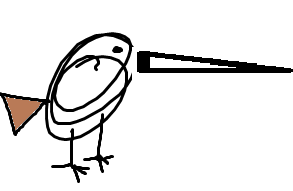Evolution introduction
An introduction to Darwin's theory of Evolution
 After watching a short video introduction to evolution, students answer questions to complete structured notes, about the different types of evidence which support the theory. This is followed by an activity which illustrates the way evolution causes a gradual change in heritable characteristics. In a final activity students look at evidence provided by the fossil record, selective breeding of domesticated animals and homologous structures.
After watching a short video introduction to evolution, students answer questions to complete structured notes, about the different types of evidence which support the theory. This is followed by an activity which illustrates the way evolution causes a gradual change in heritable characteristics. In a final activity students look at evidence provided by the fossil record, selective breeding of domesticated animals and homologous structures.
Lesson Description
Guiding Question
In this example 'Blob creatures' eat the little green peas.
The speed of 'Blob creatures' is shown by their colour.
The population size is shown by the number of Blobs on the white square, and in the histograms.
The position of the blobs is not important in this example, but notice that the three images are at different times.
What is happening to the population over the 100 days of the experiment?
Run the model yourself - click here if you wish. This Interactive is made by MinuteLabs.io.
Extension question: Does this sort of model provide real evidence in support of evolution?
Activity 1 - The evidence for evolution
What is the evidence for evolution?
Watch the short video below from Stated Clearly
then answer the questions on the Introductory questions on evolution student's sheet.
Activity 2: Evolution illustration
Complete the activity on the Evolution illustration worksheet to illustrate how how evolution could lead to a gradual accumulation of differences in the average beak length of a species of birds
Activity 3 Review of the main concepts.
Follow this short powerpoint presentation to summarise the main concepts in this introduction to evolution.
Teachers notes
The guiding question is framed as an activity so that students can spend a few minutes thinking of what they already know about the topic of evolution. Working in pairs will get everyone using words which relate to the struggle for survival in this simplified model of evolution. It is hoped that some students will notice that the population has changed during the 100 days but that individuals don't change, they either live or die. Some may be able to say that the blob creatures have evolved to be more speedy when looking for food. some may deduce that the characteristic of speed much be inherited by the offspring.
If the discussions are fruitful, try asking probing questions of students.
- What has happened to the green blob creatures from day 1?
- Can you describe how the average speed of the population changes from day 1 to day 50?
- Where do you think the variation in speed comes from?
- Why might it be an advantage to move faster in this simulation?
- Does this simulation provide evidence of evolution?
Simulating natural selection - by Primer on Youtube - shows the whole of the blob creature simulation here. It is a bit too detailed for the beginning of this section, but may be a great plenary activity at the end of the topic.
It could be the starting point for an IA or and extended essay - there is an interactive app which collects data here.
There is an interactive simulation: https://labs.minutelabs.io/evolution-...
And an overview video of that simulator: https://youtu.be/6nMo8T3T0L4
Activity 1 is an introduction to the concept of evolution, beginning with a definition of evolution as, "A cumulative change in the heritable characteristics in a population over time". Students can answer questions about the ideas in the video in the worksheet provided.
There are some model answers to the questions in Activity 1 here: Evolution introduction - model answers
Activity 2 is a practical illustration of the process of evolution in birds with longer and shorter beaks. By calculating actual sizes of beaks and then averages in the population student can see that no individual changes beak length, but that because some birds die the population average increases.
Activity 3 is a way of discussing some of the evidence and consolidating the key concepts while giving students notes on important pieces of evidence, adaptive radiation, and homologous structures for instance.
Further Resources
These are some pages which didn't quite make it into the resources on this page.
https://evolution.berkeley.edu/evolibrary/article/evo_01 - evolutionary gems//statedclearly.com/articles/category/evolution - stated clearly articles

